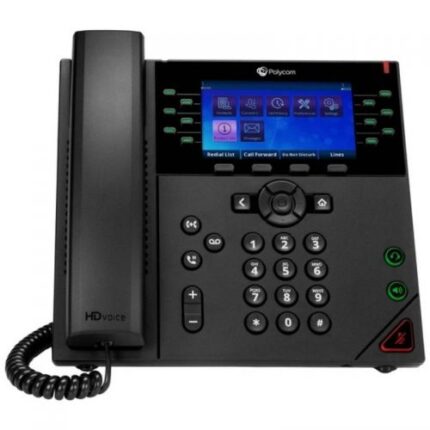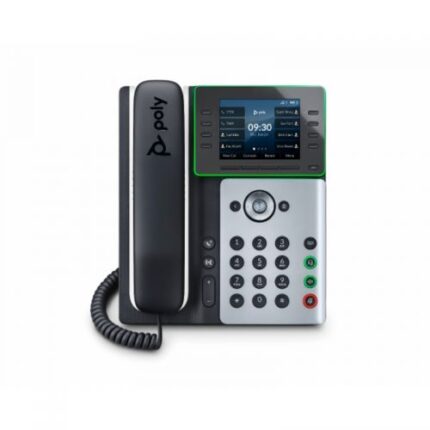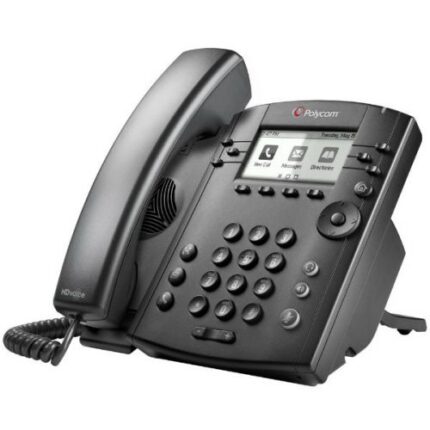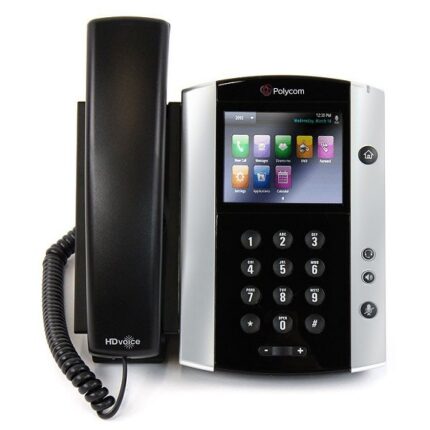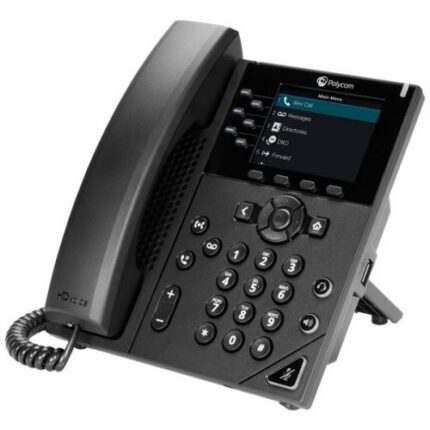Polycom Trio 8800 Collaboration Kit Technical Specifications
User interface features
- Gesture-based, multitouch-capable capacitive touch screen
- 5-inch colour LCD (720 x 1280 pixel), 9:16 aspect ratio
- On-screen virtual keyboard
- 1 USB 2.0 Type A-compliant port USB battery charging BC1.2 compliant (requires full Class 4 power input on LAN IN for operation)
- 1x USB 2.0 Micro-B device port for use as USB audio device
- Integrated Bluetooth 4.0 and NFC
- 3 multicolored capacitive-touch mute indicators
- Unicode UTF-8-character support
- User interface localised in Arabic, Chinese, Danish, Dutch, English (Canada/ US/UK), French, German, Italian, Japanese, Korean, Norwegian, Polish, Portuguese, Russian, Slovenian, Spanish and Swedish
Audio Features
- 3 cardioid microphones
- Loudspeaker – Frequency: 100-22,000 Hz – Volume: 92 dB at 0.5-m peak volume
- 6-m/20-foot microphone pickup range
- Supported codecs: G.711 (A-law and μ-law), G.722, G.729, SILK
- Polycom® Siren™ 7 (16 kbps)
- Polycom® Acoustic Clarity™ technology provides full-duplex conversations, acoustic echo cancellation and background noise suppression – Type 1 compliant (IEEE 1329 full duplex)
- Polycom® NoiseBlock™
- Voice activity detection
- Comfort noise generation
- DTMF tone generation (RFC 2833 and in-band)
- Bluetooth device pairing for wideband speech and multimedia streaming (HFP/AD2P)
Call Handling Features
- Up to 3 lines (max. one Skype for Business)
- Shared call/bridged line appearance
- Distinctive incoming call treatment/call waiting
- Call timer and call waiting
- Call transfer, hold, divert (forward), pickup
- Called, calling, connected-party information
- One-touch speed dial and meeting join
- Do-not-disturb function
- Local configurable digit map/dial plan
- Corporate directory access using LDAP
- Visual conference management
Networking and Provisioning
- Open SIP and Skype for Business/ Microsoft Office 365/Lync 2013 SDP
- IETF SIP (RFC 3261 and companion RFCs)
- Two-port gigabit Ethernet switch: 10/100/1000Base-TX across LAN and 2nd port, 2nd port supports IEEE 802.3af PSE
- Wi-Fi network connectivity: 2.4 – 2.4835 GHz (802.11b, 802.11g), 5.15 – 5.825 GHz (802.11a may vary by country), 2.4 and 5 GHz (802.11n)
- Manual or dynamic host configuration protocol (DHCP) network setup
- Time and date synchronization using SNTP
- FTP/TFTP/HTTP/HTTPS server-based central provisioning
- RealPresence Resource Manager (v. 10.1 or above) based provisioning
- Polycom Zero Touch Provisioning
- Provisioning and call server redundancy support
- QoS support: IEEE 802.1p/Q tagging (VLAN), layer 3 TOS, and DSCP, WMM (Wi-Fi multimedia)
- VLAN – CDP, DHCP VLAN discovery
- LLDP-MED for VLAN discovery
Security
- 802.1X authentication and EAPOL
- Media encryption via SRTP
- Transport layer security (TLS) v 1.2
- Encrypted configuration files
- Digest authentication
- Password login
- Support for URL syntax with password for boot server address
- HTTPS secure provisioning
- Support for signed software executables
- Wi-Fi encryption: WEP, WPA-Personal, WPA2-Personal, WPA2-Enterprise with 802.1X (EAP-TLS, PEAP-MSCHAPv2)
Power
- LAN IN: Built-in auto-sensing IEEE 802.3at. PoE Device (Class 4) (requires full Class 4 power input on LAN IN for operation). Backward compatibility with IEEE 802.3af.
- LAN OUT: Built-in auto-sensing IEEE 802.3af power sourcing equipment (requires full Class 4 power input on LAN IN for operation)
Approvals
- Japan MIC/VCCI Class B
- FCC Part 15 (CFR 47) Class B
- ICES-003 Class B
- EN55022 Class B
- CISPR22 Class B
- VCCI Class B
- EN55024
- EN61000-3-2; EN61000-3-3
- NZ Telepermit
- Australia A&C Tick
- ROHS compliant
- 19471-0715
Radio
- US: FCC Part 15.247, FCC Part 15.407, FCC Part 15.225
- Canada: RSS 247 Issue 1
- EU: ETSI EN 300 328 v1.9.1, ETSI EN 301 893 v1.7.1, ETSI EN 300 330 , ETSI EN 301 489-3, ETSI EN 301 489-17
- Japan: Japan Item (19), Japan Item (19)-3, Japan Item (19)-3-2
- Australia: AS/NZ4268
Safety
- UL 60950-1
- CE Mark
- CAN/CSA-C22.2 No. 60950-1-03
- EN 60950-1
- IEC 60950-1
- AS/NZS 60950-1
Environmental conditions
- Operating temperature: 0 to 40°C (+32 to 104°F)
- Relative humidity: 5% to 95% (non-condensing)
- Storage temperature: -20 to +70°C (-4 to +160°F)



